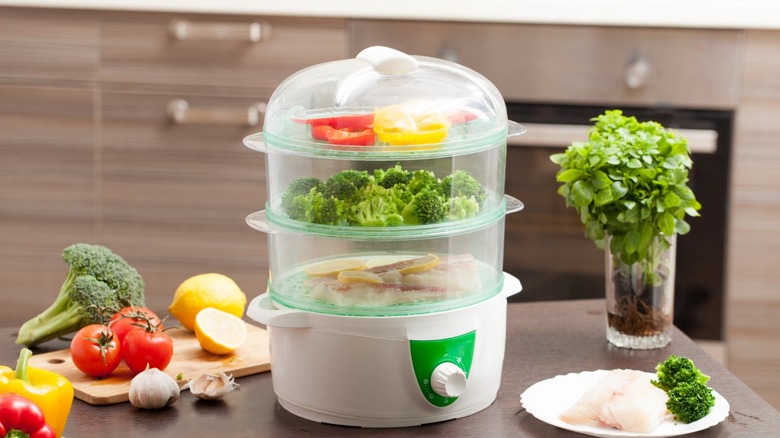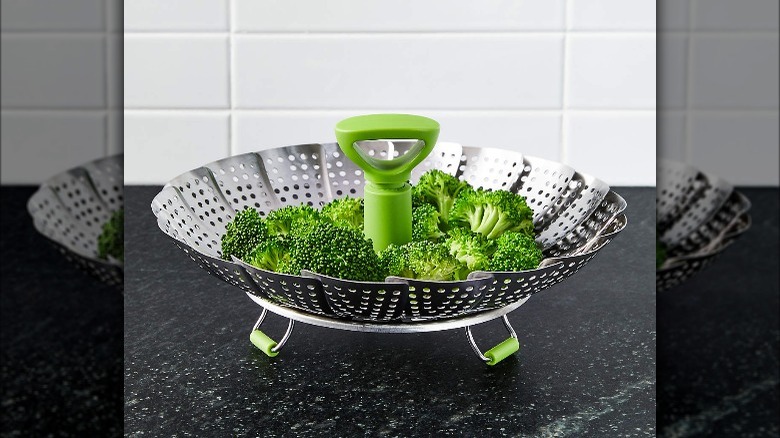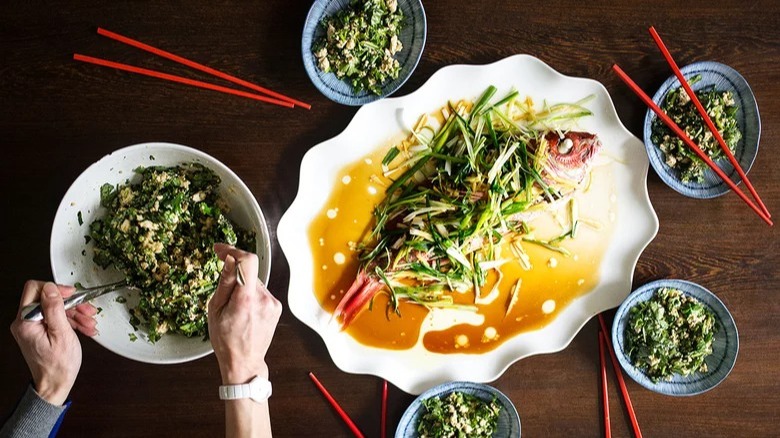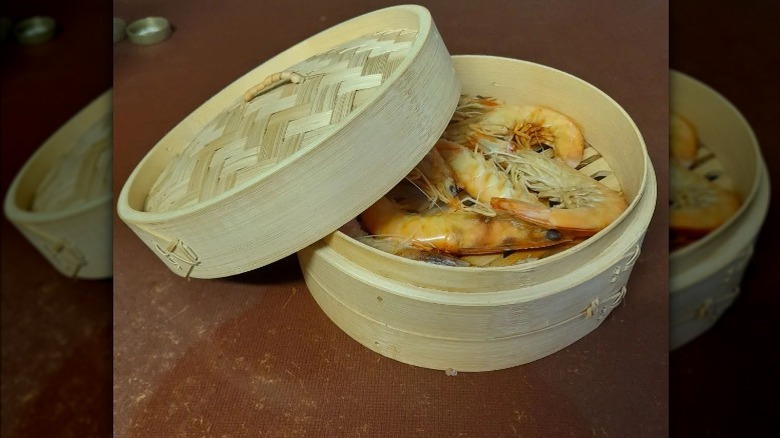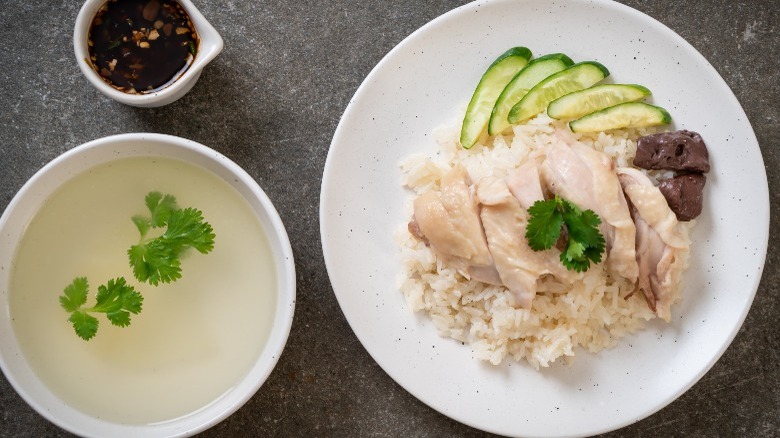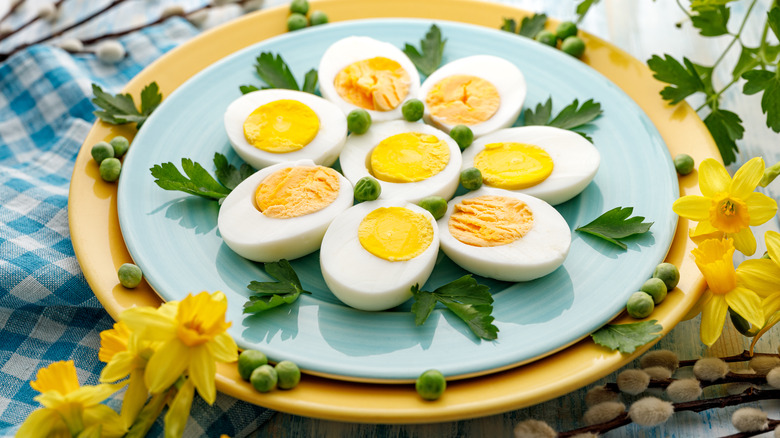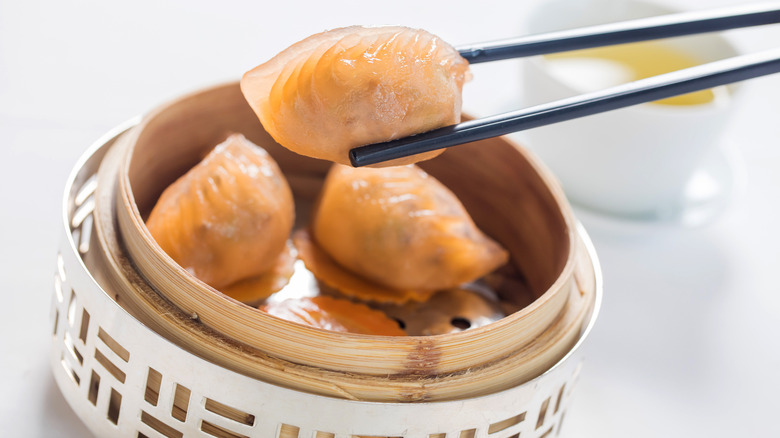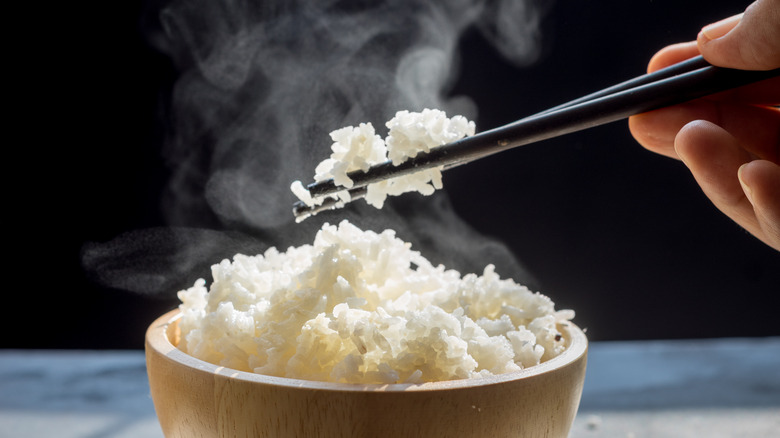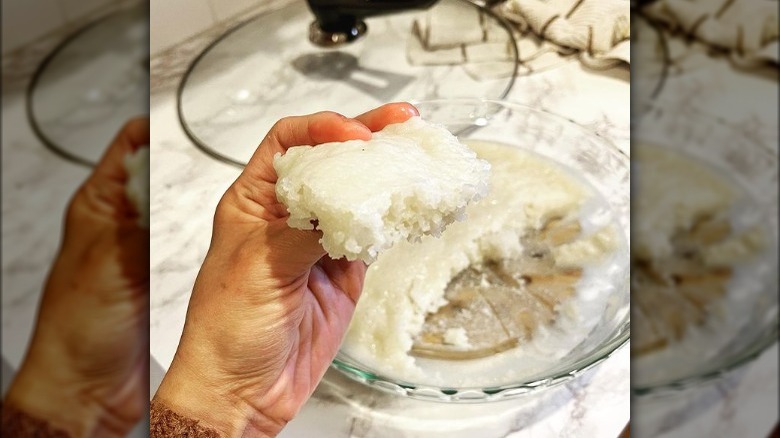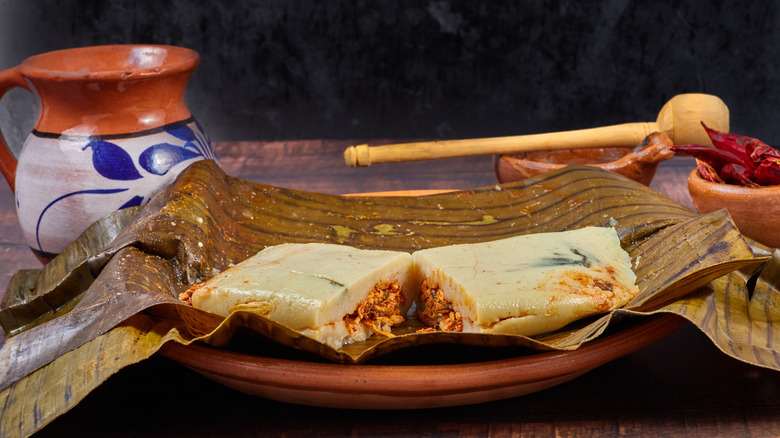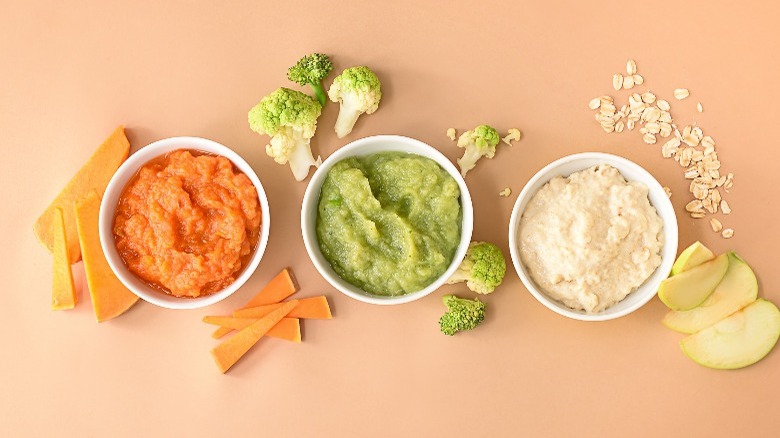The Absolute Best Uses For Your Vegetable Steamer
People often turn to steaming food when they want to eat healthier, as it helps avoid added calories in the form of cooking oils. Not only does it maintain the nutritional content of food, but it gives the purest, natural taste (via Crave).
There are several types of vegetable steamers available, so make sure you purchase the one that best suits your kitchen needs. The simplest is the collapsible stainless steel steamer baskets that fit into various pots and pan (via Gourmet Food). This tool is easy to use and store, requiring just a pot or pan and some water. If you plan on preparing East Asian cuisine, such as Chinese, consider a bamboo steamer. These multi-layered baskets can fit inside woks and frying pans with water in the bottom (via The Woks of Life). Electric vegetable steamers are slightly more complex, but they often have various components built for specific purposes, such as a rice bowl. A tray in the bottom of the device holds water and produces the steam needed to cook your food (via Aicok). Just be sure to avoid the mistakes everyone makes when steaming food.
No matter the type of steamer (or steamers) you own, they are great for any kitchen, especially considering their versatility beyond vegetable cookery. Here are the best 10 ways to take advantage of your vegetable steamer.
Stick with vegetables
This may be the most obvious use of a vegetable steamer, but it is a time-tested practice. Steaming vegetables is easy and quick, and you won't lose out on nutrients often wasted in other cooking methods (via CNN). According to The Pioneer Woman, a metal steamer basket is the best tool to use for vegetables if you do not have an electric steamer.
For perfectly steamed vegetables every time, follow these simple rules: Cut your produce into uniform pieces; do not allow the simmering water (which should be unsalted) to reach the steamer basket; and do not overcook, or you will end up serving mush. Not all vegetables cook at the same rate. Arugula, spinach, and other leafy greens take just two to three minutes to steam, while potatoes and squashes can take up to 20 minutes. Test for doneness by piercing the vegetables with a fork; they are ready when they feel tender. Serve plain or season your dish to your desire.
Feast on a whole fish or filet
Steaming is an incredibly healthy way to prepare fish, and it keeps the flavor intact. While often seen as boring or bland, when done right, steamed fish can be a delectable treat. Discover Seafood finds metal or bamboo steamers to be ideal for fish preparation, but you can also use your electric steamer. Keep in mind that most vegetable steamers can only handle a limited amount of fish. This method will work for small to medium whole fish or a few fillets. For the best results, choose fish that is fresh, with bright, metallic looking skin and clear eyes with little to no fishy smell (via Los Angeles Times).
Like with vegetables, it is important to not overcook your fish, as this can result in an unpleasant texture and flavor. Good Housekeeping instructs 10 minutes of steaming per inch of thickness. When the flesh is opaque throughout, that means it's ready.
Give shellfish a steam
Seafood in a shell is also ideal for steaming. When dealing with mollusks, cook them in a covered pot (as per the instruction for this steamed clams with shallot butter recipe), so that they absorb the flavors of the cooking liquid. Bivalves such as these are not best suited for a vegetable steamer, but other shellfish like shrimp and crab legs work well in them.
According to Food Network, cooking shrimp in a steamer can help prevent the rubbery texture that often comes from boiling, as steaming is a gentler cooking process. They recommend brining the shrimp beforehand in a solution of salt and water and also adding flavor through the steaming liquid, such as adding aromatics or using stock, beer, or wine. It will take about four to six minutes to steam 1 to 2 pounds of shrimp. Crab legs are another shellfish option to prepare in your vegetable steamer. Martha Stewart recommends letting them cook for four to five minutes. If you're using frozen seafood, add a few extra minutes to the cook time.
Ensure your chicken breast is tender
For all its versatility, chicken breast is rather difficult to cook well, as most methods can leave your meat dry and rubbery. In addition to the health benefits, steaming chicken breast can result in tender, juicy meat without added oils. Allot around 30 minutes for steaming chicken, but keep in mind that the cooking time will depend upon the thickness of the breast. Use a meat thermometer to check for doneness — per the U.S. Department of Health and Human Services, chicken should reach an internal temperature of 165 F to be safely consumed.
There are plenty of ways to add flavor to your steamed chicken. SFGate suggests seasoning prior to steaming and adding fresh herbs, citrus, spice blends, or nori to the steamer basket. If you're a fan of dark meat, go ahead and steam chicken thighs. Taste Asian Food recommends marinating the with rice wine, oyster sauce, soy sauce, and sesame oil and then using any drippings in the steamer to make a sauce.
Make perfect hard-cooked eggs
Gone are the days of waiting for a pot of water to boil. With your vegetable steamer, you can hard-cook eggs to perfection every time with shells that will peel with ease. (Simply Recipes explains that air from the steam passes through the egg shell, aiding in the peeling process.)
No matter if you use an electric steamer, metal basket, or bamboo steamer, follow these cooking times for your desired doneness. Serious Eats recommends steaming for six minutes if you prefer a runny yolk and 12 minutes for a fully cooked center. If you like a jammy yolk, a nine minute steam should do the trick (via Cooking Classy). Make sure to have a bowl of ice water ready to go. Immediately placing the steamed eggs in an ice bath speeds up cooling and stops any carry-over cooking, avoiding that green ring that comes with an over-boiled egg. This genius trick will ensure that you'll never have those sulfuric smelling hard-cooked eggs ever again.
Steam Chinese dumplings
Chinese dumplings, called jiǎozi, are a favorite item on most Chinese take-out menus, but you can make your own at home using your vegetable steamer. The Woks of Life finds this to be an excellent way to prepare dumplings, as it allows you to highlight the filling more than pan or deep frying would. While bamboo steamers are more traditional, you can use any steaming set up. For bamboo steamers, use a liner to prevent the dumplings from sticking to the bottom; a non-stick cooking spray should do the trick for metal or plastic steamers (via Kitchn).
If you have the time, we recommend preparing dumplings from scratch. For this steamed beef dumplings recipe, whip up a hot water dough in the food processor and make a filling of ground beef, vegetables, and flavor agents like ginger, Szechuan peppercorns, soy sauce, and rice wine. After rolling out the dough, stuff with the raw filling and place in your vegetable steamer for about six minutes. You should check with a meat thermometer to make sure the filling cooked through.
For those who aren't prepared to take on such a project, there are a multitude of frozen dumplings you can buy that are great for steaming — just be sure to check the package for cooking instructions.
Prepare fluffy rice or couscous
Many people choose to cook rice by boiling on the stovetop, but you should consider using a vegetable steamer. Short grain rice is ideal for steaming, resulting in a texture that works well with chopsticks (via The Spruce Eats).While rice cookers are specifically designed for this task, they have a singular use and you may not have the extra room in your kitchen. Since the holes in vegetable steamers are too large for most grains, some electric steamers come with a specific rice bowl with smaller perforation (via LiveStrong). Alternatively, you can line the bottom of your steamer with cheese cloth. LiveStrong calls for rinsing rice beforehand to wash off the starchy coating if you do not want sticky rice. It will take about 15 to 30 minutes to steam. Make sure to let the rice sit in the steamer for an additional five minutes with the lid on before serving.
Similarly to rice, you can get really fluffy couscous from a vegetable steamer. The Matbakh recommends a double steam method. Starting with a pound of dry couscous, first allow it to absorb 1½ cups of room temperature water and then add to your steamer for about 15 minutes. Remove the couscous from the steamer and mix in another cup of water. Then return the couscous back to the steamer for another 15 minutes.
Make a steamed cake
This next use for your vegetable steamer may come as a shock: You can use it to make desserts, including cakes. A steamed sponge cake called bak tong gou is a traditional Chinese sweet popular to finish off a dim sum meal (via Food52). Made with yeast, this cake has a surprising chewy, brioche-like texture with a hint of sweetness that will be ready in 20 to 25 minutes.
Many other cakes can be steamed, and the main benefit of going this route, per Jaja Bakes, is texture. While chocolate cake may end up dry using conventional baking methods, making it in a steamer will result in a moist, light crumb. You can also go eggless using this method by swapping in yogurt and oil (via Hebbars Kitchen). These cakes are great for the summer when you want something sweet but don't want to heat up your kitchen.
Steam tamales for a party
While there are variations throughout Latin America, tamales are most familiar to American eaters as a traditional Mexican food made from corn masa wrapped in either banana leaves or corn husks. Fillings can be savory with meat and cheese or sweet with fruit, such as spiced pineapple. Tamales are traditionally steamed in their wrapping, making them perfect for your vegetable steamer. Unlike other steamed foods, you can actually stack these tiny packages, which is ideal if you want to make tamales for a crowd.
This is not a quick-cooking product, however, as the process can take up to two hours. Because of the extensive cooking time, you may need to add more water to your steamer at some point. If your tamales are still mushy and stick to the wrapping, they are not done cooking — they will feel firm when fully steamed.
Whip up homemade baby food
There is a plethora of baby food on the market, but getting the best products in those cans and pouches can come at quite a cost. Making homemade baby food can be done with ease using just a vegetable steamer and a food processor. This is a great way to introduce fresh produce to your children.
The benefits of steaming over other preparation methods for making your own baby food is that you will maintain the highest percentage of nutritional value (via Baby Sleep Site). To prepare your produce, follow our guidelines for steaming vegetables, including cutting them into uniform sizes for even cooking. Babylist instructs to steam your washed fruits in vegetables for about 10 minutes, or until you can mash the pieces with a fork. If you are just introducing your baby to solid foods, Babylist recommends pureeing in the food processor, but if they have been eating for awhile, you can transition to mashing with a fork for chunkier pieces. You can also make large batches and freeze leftover baby food.
